Mike Vrabel just can't seem to crack the top 10 of any head coach rankings.
from NFL News, Scores, Fantasy Games and Highlights 2020 | Yahoo Sports https://ift.tt/3600kas
Mike Vrabel just can't seem to crack the top 10 of any head coach rankings.
The Titans finished just ahead of the Colts to win the AFC South last season and both clubs have made some big changes this offseason. Carson Wentz is now the quarterback in Indianapolis while Julio Jones has joined A.J. Brown at the top of the Titans’ wide receiver group. During a recent appearance on The [more]
Offensive tackles are among the NFL's most important players, and here are the 11 best in the business.
Olsen caught 524 balls in that number over his nine years as a member of the Panthers organization.
The Cowboys made 3 huge WR trades in the last 20 years; they're 1 for 3. The wrong failure may be getting more press than the true villian.
Portland hired Chauncey Billups, not Hammon.
DeAndre Ayton's star turn has been impressive—but it's also forcing us to reconsider his ceiling.
Welcome to the Morning Shootaround, where every weekday you’ll get a fresh, topical column from one of SI.com’s NBA writers: Howard Beck on Mondays, Chris Mannix on Tuesdays, Michael Pina on Wednesdays, Chris Herring on Thursdays and Rohan Nadkarni on Fridays.
About a week before Christmas in 2019, Deandre Ayton was late to a game at Staples Center against the Clippers. It was his first in nearly two months, thanks to a 25-game suspension handed down by the NBA after Ayton violated its drug policy by testing positive for a banned diuretic. In the aftermath, Suns general manager James Jones issued the type of self-condemning statement that teams rarely make toward one of their own building blocks, writing: “This does not uphold the standards and principles we have set for the team.”
Ayton was apologetic and sincere addressing his punishment and return on that December night. At the same time, he brushed off his tardiness as incidental, later blaming it on “L.A. traffic.” The Suns struggled during their No. 1 pick’s absence, but Aron Baynes, their 32-year-old backup center, played well enough (when he was healthy) to create something of an awkward dynamic upon Ayton’s return, given his presumed importance in the short- and long-term as a starter.
Ayton sprained his ankle against the Clippers. Then, when he made his second comeback six games later, he came off the bench in five of the next eight. The three he started were at power forward, next to Baynes. Ayton was out of shape, rushing shots, inconsistently diving hard to the rim. Through it all, Monty Williams—who coached Anthony Davis during his first three seasons—wasn’t fazed. “We’re going to develop him and bring him along the right way,” Williams said at the time.
Fast forward to last week, minutes after the Valley-Oop instantly cemented itself as an iconic moment in franchise history. Ayton was bouncing through questions during a celebratory postgame press conference when a reporter asked how he’s come to realize the difference between showing up to collect a paycheck and showing up to earn it. “There was times where I wouldn’t even come in on days off,” he said, before praising the effect his head coach has had.
But some bumps still carried into this year. “To see his growth, man, I get goose bumps, seriously,” Chris Paul recently said. “We done had some heated conversations this season, especially earlier in the season, but man, I genuinely love him.”
There have been nights during this postseason when all of that struggle, the growing pains and hard lessons feel like they were endured in a previous lifetime. The player Phoenix hoped and prayed it was getting when it chose Ayton ahead of Luka Dončić and Trae Young has arrived ahead of schedule, granted in a much different form than anyone anticipated.
Far from the capricious X-factor so many expected to see heading into the playoffs, Ayton has instead enjoyed the most consistent and significant breakout run of any young player. Young has no doubt starred, but he also started last year’s All-Star game and has long been guaranteed to receive a max contract extension as soon as he became eligible. Ayton was more of a mystery box. So far, he’s been the absolute best version of exactly what Phoenix needs.
When recently asked about the seemingly overnight transformation from a solid but unreliable two-way anchor who might not hold up against the rigors big men must deal with in playoff games that are largely decided on the perimeter, Ayton recently said “Honestly, the world having me as a question mark in the playoffs, that got to me a little bit. And I’m going to change that.”
Change it he has, in interesting ways. Ayton is making 70% of his 10.7 field goal attempts per game, and 79% at the rim, where 7.1 of those tries come from. Heading into this postseason (reminder: it’s Ayton’s first!), the highest field goal percentage any player has ever had taking at least 150 shots was James Worthy’s 62.2% in 1985. The gap between Ayton’s field goal percentage and Worthy’s is the same as Worthy and 77th-ranked Kiki Vandeweghe, who shot 54.4% in 1983.
As a roll man, we haven’t really seen anything that rivals Ayton’s volume or efficiency, a fact supported by data and the millions of eyes that are watching him regularly sky over the box to catch lobs that’d otherwise reach the third row, or muscle his way through traffic and still finish over a rotating backline defender.
According to Synergy Sports, 30.2% of Ayton’s possessions in this postseason are finished as a roll man, which is up 11% from the regular season. The increase makes sense when you consider that in Synergy’s entire database—which goes back to the 2005 playoffs—the only player (on a minimum of 50 possessions) who has ever been more efficient after setting a screen is 30-year-old Al Horford. All the buckets Ayton has scored in these situations don’t even account for the wide open threes he produces by rolling his massive frame toward the basket. (Cam Johnson and Mikal Bridges say thank you.)
All the fat has been burned out of Ayton’s attack. By focusing on less glamorous sides of the game (putbacks, rim runs, contested rebounds, sturdy pick-and-roll defense, screens, etc.) he has excelled without stretching himself in ways that might blunt his impact.
Out of every Suns player who’s logged at least 100 playoff minutes, he ranks sixth in usage rate, behind Dario Šarić and Torrey Craig. This less-is-more coming out party creates a few separate ways to view Ayton’s run. One is that he couldn’t be in a more ideal spot, surrounded by elite three-point shooters, ball movers, a point god and another top-tier scorer who attracts a massive amount of attention. Almost 90% of all Ayton’s shots have come in the paint, 83% have been assisted (up from 72% during the regular season) and despite averaging five more minutes in the playoffs, his post-ups have been cut nearly in half.
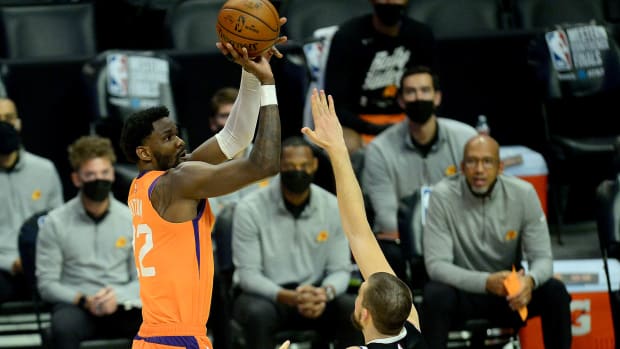
All this has served him and the Suns well. As has a quality of competition that hasn’t been, shall we say, intact. If you’re an Ayton skeptic, you’ll quickly point to the fact that he has not been forced to match up against a healthy Anthony Davis, the lethal Jamal Murray–Nikola Jokić pick-and-roll or small-ball lineups that have Kawhi Leonard in them. This is obviously unfair to Ayton, who has no say over his opponent’s health. All he did in the second round was neutralize Jokić one-on-one better than any big man has, while dominating his space against three teams that haven’t been able to exploit his shortcomings.
It hasn’t all been smooth, though. In Game 5 of the conference finals, with Ivica Zubac out of the lineup, some of the issues tied to what Ayton can’t or won’t do could not be ignored. The Clippers defended him with Nicolas Batum or Marcus Morris and stayed small, either switching pick-and-rolls that involved Paul or Devin Booker or forcing the Suns to attack a smoke-and-mirrors zone.
Ty Lue’s bet was that Ayton couldn’t pound his guards and wings in the post; every time the Clippers fronted him until he gave up and drifted out of the paint, it paid off. (On one early paint catch off a roll, Ayton tried to seal Terance Mann but was moved off his spot before a quick jump hook fell short. The Suns made little effort to feed him from that point on.)
That was only step one, though. L.A. further offset Ayton’s force by crashing the glass as a group whenever he seemingly held inside position on his man. Ayton only came up with three offensive rebounds (down from a whopping nine in Game 4).
On the defensive end, the Clippers treated Ayton (who finished -22) exactly how they did Rudy Gobert in Game 6 of the previous round, putting whoever he was guarding in the strongside corner and then driving that half towards the rim. The results would either be a decent look around the basket or, if Ayton helped—which he just about never did, unlike Gobert—an open-corner three.
Afterward, Lue was asked why he went with Batum over Mann (who killed Gobert from the corner in that Game 6). “I just wanted to try to get Ayton out of the paint a little bit more. I wanted to see who he was going to guard, with Marcus and Nico in there at the four and the five. So it worked out in our advantage. I just think being able to spread him out.… It was great for us because now we were able to move him around a little bit more and we were able to get open shots.”
Outside that uncomfortable stretch, Ayton’s defense has been stellar, enough for his coach to make some borderline outlandish comparisons earlier in the series. “DA has defensive gifts that not many bigs have. The guy that he reminded me of is like two guys, LaMarcus [Aldridge] and [Kevin] Garnett in pick-and-roll coverages, the way that they talk and their athleticism to switch and cover for the guy on the ball.”
You can’t teach size. You can’t teach strength. You can’t teach the coordination, skill and touch Ayton has as a 22-year-old. And that brings us to yet another way to process Ayton’s first playoffs: with a splash of optimism! Looking back on the 2021 playoffs in five years, the most telling part of his revelatory run might just in fact be everything he isn’t doing.
This is not a call for Ayton to step outside his lane anytime soon, but using this postseason as a baseline, one that should infuse him with plenty of confidence going forward, it’s hard not to rethink Ayton’s ceiling.
Consider, as an example, his outside shot. Again, this isn’t a call for Ayton to extricate himself from the paint. But there should be a day when leaving him open at 18 feet isn’t survivable. A threat that can open lanes for everybody else. All the better if/when he develops a reliable three-point shot.
Ayton’s rolls have been devastating, but there will soon be a day when Paul isn’t around to unlock them. When defenses sink in to take away those point-blank opportunities, Ayton can pop out to the midrange for open looks that he’s already comfortable taking and making.
The next element worth a look is his post game, which has disappeared—with good reason—in these playoffs. Ayton’s post-ups are down from 27.5% of his used possessions during the regular season to 11.6% right now, where he’s scoring a paltry 0.54 points per possession.
Back-to-the-basket bully ball doesn’t need to be the primary way Ayton attacks similarly sized centers. But if he can develop a more patient game on the block, one that gift wraps his freakish agility and raw power into a package that can draw double teams, instead of settling for the quick face-up jumpers he’s fallen in love with, Ayton can be even more of a matchup nightmare than he already is. He can initiate offense more often than he finishes it while punishing teams that go small against him—as the Clippers did on Monday.
There won’t be as much urgency for Ayton to develop if the Suns win the title. But if they come up short, Paul’s pending exit shines light on Ayton’s inevitable need to be more self-sufficient. (“I think he was the best thing that happened to my career,” Ayton recently said about his point guard.)
None of this is aimed to delegitimize an incredible playoff debut from an absurdly talented prospect who’s been willing to sacrifice for the good of his team. Ayton was humbled early in his career. And while he likely wouldn’t choose that road again, the adversity served a purpose: Instead of producing like a typical first pick might, he’s embraced and shined in a much simpler role, free of pressure and complexity.
What that says about who he can be going forward is very much up in the air. If you’re bullish, Ayton is just scratching the surface of a skill set that will eventually make him an unstoppable weapon. If not, all his weaknesses will be particularly damaging in the future, when Phoenix’s roster is less ideal than the magical one they’ve constructed in his third season.
More NBA Playoffs Coverage:
• Playoff P to the Rescue for the Clippers
• Beck: The Irony of the Mavericks' Hires
• Pina: The NBA Playoffs All-Money Team
• How It Feels to Watch the Team You Built Thrive Without You
Which legendary quarterback would have had the better career if they'd been drafted by their counterpart's team? Plus, the Jaguars' odds, Trey Lance's ceiling, the best concerts and hot wings, and more.
We’re heading into what promises to be a lovely Fourth of July weekend here in the Northeast. Albert Breer is on vacation and I’ve decided to take some time away from ordering nonalcoholic craft beer and perfecting my Old Bay potato salad recipe to answer some questions from his stuffed mailbag.
Let’s boogie …
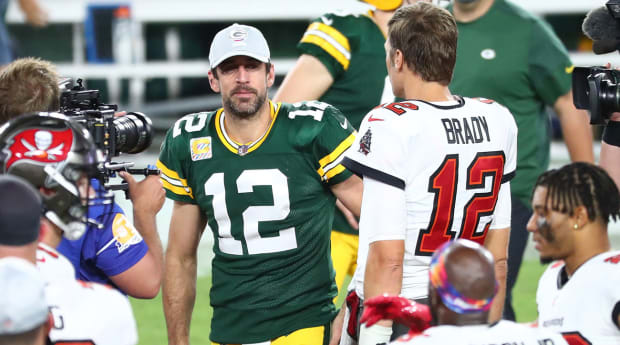
From Myles Powicki (@MylesPowicki): How many Super Bowls would Tom Brady have on all of Aaron Rodgers’s teams and vice versa?
Hey Myles, thanks for submitting this very interesting question. I talked to former Giants safety Antrel Rolle not long ago, and he was talking about how their three-safety look puzzled both Brady and Rodgers alike during their 2011 run to the Super Bowl. My point here is that there were some brief innovations in NFL history that may have stymied both of them equally. That said, I think that Rodgers would have won three, maybe four, of the seven Super Bowls Brady won over that same window. I think Brady would have won zero of the Super Bowls that Rodgers won on the Packers, and here’s why …
New England in the early 2000s was the closest thing we’ve had to a true, nonpolitical meritocracy in the NFL. I don’t know if Brady, had he been
drafted in the seventh round by the Packers, would have had the chance to rise through the organization like he did in New England, thus cementing himself as a journeyman backup. He was obviously good enough to become the greatest player in NFL history, but I think a lot of his rise had to do with a willingness from the Patriots’ coaching staff to buck traditional thinking and pour their resources behind someone like Brady, along with Brady’s ability to see that working the way he did was going to be rewarded. A lot of teams preach hard work, but few of them, I think, would have recognized and valued the little things that Brady did, like obsessively study opponent quarterbacks in order to give the Patriots the best scout team looks in practice. So, I think Rodgers would have done Rodgers things in New England on very good rosters with a great offensive coordinator. I think Brady would have supplanted Brett Favre in an offense that didn’t necessarily bend to his skill set, and he’d have had a difficult time ever achieving the kind of liftoff he had with the Patriots.There are so many aspects of the Brady mythos that are situationally dependent. For example, would he have met his controversial super-trainer, Alex Guerrero, if he had not been in the locker room with Willie McGinest back in 2006 when the Patriots’ star defensive player started bringing Guerrero around? What would the back end of his career after his 2008 ACL tear have looked like otherwise? Would Brady have been able to succeed on a Packers roster that notoriously shunned the acquisition of free agents, unlike a Patriots roster that, over the years, acquired the likes of Randy Moss and also built one of the NFL’s real, top-to-bottom, middle-class rosters full of talented veterans hanging in New England’s orbit at a discounted price in order to win a championship?
Would he have won as frequently with Mike Sherman or Mike McCarthy, who were notoriously stubborn when it came to their systems, instead of Bill Belichick and Josh McDaniels, who changed the way teams custom game planned for opponents (a large part of which, we admit, Brady also had a significant hand in)? Would he have won as many games without being in an offense for the better part of 20 years (one he carried with him to Tampa Bay, essentially convincing the Buccaneers to reroute at the end of the 2020 season to run)? Would Brady have gotten famous and expensive enough to take a notoriously lower contract to aid in Green Bay’s roster construction over a long period of time?
I think from a talent perspective, most of us can agree that the raw, God-given tools Rodgers has to work with are slightly better than the ones Brady was born with. Rodgers is a tremendous competitor, though Brady may have redefined the meaning of competitiveness over his tenure in the NFL. Is that enough on its own to have transformed him into the player he is now without all of the other mitigating circumstances? Have there been other Bradys over the course of NFL history who had the will and the work ethic to reach that level, but were ditched by coaches scared of the optics, thus shooting down promising careers before they started?
Brady needed to be paired with Belichick, the guy who had the fortitude to fire Bernie Kosar in Cleveland and, later, the guy who was comfortable moving on from Drew Bledsoe, in order to set a lot of this in motion. Rodgers, meanwhile, could have been put on a lot of rosters and won Super Bowls simply by virtue of being an exceptionally talented and driven player. And, because he was a first-round pick, he inevitably would’ve gotten more chances.
From Stagger McTipsy (@StaggerMcTipsy0): What is the best concert you’ve ever attended?
Thanks for the question, Stagger. Those who have read some of my work can probably guess which direction this is headed. I would say my first “real” concert, which was the Allman Brothers and Moe. at Montage Mountain in Moosic, Pa., will always hold a special significance in my heart. I have seen Moe. about a half dozen times now and have always enjoyed the atmosphere at their shows. A close second would be Joe Russo’s Almost Dead, which I caught at the Brooklyn Bowl. They had John Mayer, who currently tours with Dead and Company, sit in on Althea, and it was really special. I was always bummed I didn’t get to see The Grateful Dead in their prime (mid-to-late 1970s), but this felt about as close as I could come. Young, talented musicians really capturing the spirit of the thing.
Other close seconds and thirds:
• Rage Against the Machine, Rock the Bells 2007
• Tom Petty and the Heartbreakers at the Fillmore in Philadelphia
• Paul McCartney at MetLife Stadium, 2016
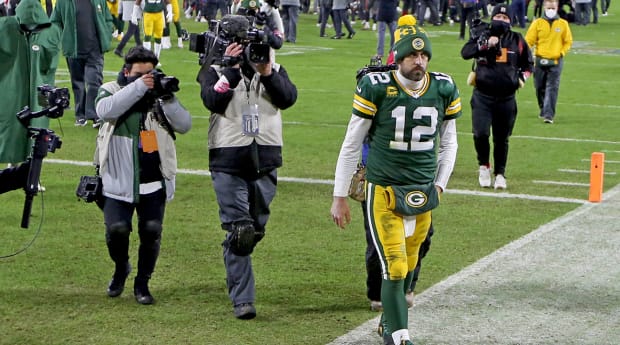
From Craig Ginsberg (@CraigAdamG): How do you see the Green Bay–Rodgers saga ending?
Hey Craig, thanks for the question and happy Fourth. It’s interesting; I’ve talked to people in close proximity to the situation who aren’t sure how it’s going to end. Here’s ultimately what I think will happen, based on the current state of play and my gut instinct. Rodgers, one of the most competitive people on planet earth, needs to do a much better job of convincing the Packers that he’s willing to drop everything, take a massive pay cut and sit out while Jordan Love takes a crack at this very amenable offense than he’s currently doing. I don’t think he’ll be traded. I think he’s made the strongest point that he could possibly make, and at this moment, the ball is in his court to dig in his heels and find another layer of discontent.
If I were Rodgers, I would be looking out at the teams that were allegedly on my leaked trade destinations list. The 49ers have Trey Lance, so they’re out. Then you’re looking at the Broncos and the Raiders, neither of which have an offensive identity or established weapon set. Green Bay has the offense. The one every quarterback is calling their agent to try and find a way to run. They have the coordinator whom Rodgers respects. They have a great running game and a good defense. They’ve won 13 games each of the last two years and the division is still soft. Long-term marriages are complicated, but I would speculate that he’s smart enough to realize that his best shot at winning a Super Bowl is on this team, right here, right now. I would expect that at some point early in training camp, we’ll have the frantic, CNN-style helicopter landing, and Rodgers will come out and gracefully voice his displeasure while somehow managing to scoop the upper hand on management in the court of public opinion. There will be a new contract. Then a new viewpoint on the Love replacement timeline. And, of course, a relieved Brian Gutekunst and Matt LaFleur, finally attempting to exhale.
From Tony C (@Bucz109): I have never heard of Jermyn, Pennsylvania and only live 2.5 hours away. Are the hot wings worth making the drive out there?
Hey Tony, the short answer is yes. Jermyn is home to the Windsor Inn, which advertises itself as having “the world’s second-best hot wings.” I might agree with that, as the only wings I’ve ever had that are better are at Bar-Bill in Buffalo. I made the trip home this past weekend (I was raised in Clarks Summit, Pa.) and picked up 120 wings from the Windsor to share with my friends. It was delightful. One of the rare times where something you build up in your mind during your childhood secures its excellence 17 years later.
From Michael Cameron Vegh (@MichaelCVegh): The Jaguars currently sit at 8-1 odds to win the AFC South. What would it take from their squad to win the AFC in Trevor Lawrence and Urban Meyer's first run in a seemingly winnable division?
Hey Michael, thanks for the question. I think it would take quite a lot for the Jaguars to win the division here. This is the Colts’ division to lose in 2021, and I don’t think it’s necessarily close. Carson Wentz will be back to looking like vintage Wentz in an offense that gives him reasonable reads and doesn’t force him to play hero ball on every down. The Titans will finish second and Jacksonville should hope that they beat the pulp out of the Texans twice this year and finish Meyer’s first campaign with enough steam to legitimize the massive decision to hire a collegiate coach in the first place. The Jaguars needed help stopping the run, but went with a running back for their second first-round pick. They’re in a division with Derrick Henry and Jonathan Taylor, which, regardless of how well Joe Cullen does in his first year as DC, is going to be a gargantuan task to stop.
I’ll also be watching Lawrence to see how quickly the offense goes from clunky to seamless. Brian Schottenheimer and Darrell Bevell have a lot of work ahead of them, and their schematic experiences tend to lean more pro style. Bevell did a good job protecting Russell Wilson early in his career, as did Schottenheimer with Mark Sanchez in 2009 and ’10, handing the offense over in chunks and increasing the responsibilities over time. Lawrence, though, will be expected to move at an expedited pace with a less-talented surrounding class. I’m not sure that’s possible.
From Connor Grossman (@connorgrossman): Who's the starting quarterback on the next 49ers team to win the Super Bowl? What kind of acai bowl does he like?
Connor! Miss you, buddy. It’s not the same here at SI now that people don’t mistakenly send me your emails. Trey Lance will win a Super Bowl with the 49ers. I have very little doubt about this. I think it will happen soon, quite possibly next year. Teams already have a difficult enough time stopping Kyle Shanahan’s offense. It has evolved to the point where they have answers for almost anything a defense is going to throw at them and their running game, buoyed by offensive coordinator Mike McDaniel, is the most maximized and well-understood system in the NFL. And now that everyone has spent an offseason figuring out how to crack the code, Lance can become a power rusher and destroy the math defensive coordinators have been working with for the last five years. If you are in a dynasty fantasy league and do not pick Lance, I hope you enjoy finishing out of the money each and every year.
Part II: I don’t know if Lance likes acai, or what kind, but here is my mainstay of late, courtesy of the Playa Bowls near my house: Coconut base, vegan granola, flax oil, almond butter and bananas.
From Neal (@CapitolTitans): I don’t get the Zach Wilson thing. It seems like no one besides the Jets would’ve taken him at No. 2, they just locked on and wanted him for some reason. Am I wrong about this?
Hey Neal, I would say you are kind of wrong about this (the Eagles, for one, probably would have taken him), but here’s a fun way to think about the situation: Imagine being Robert Saleh, a first-time head coach, after waiting three cycles to land a gig. The first thing your team does is pick a quarterback. You’re a defensive-minded head coach, so a lot of the legwork is going to fall on the general manager and the offensive coordinator. The guy picking behind you was Kyle Shanahan, your former boss, who jetted up the draft board once it became obvious that you were taking Zach Wilson to select the guy after you. Would you be worried in the least? Would there be any hesitation?
I’m not saying any of this is true for Saleh, but it underscores the faith he must have in Joe Douglas and the faith the Jets have in Douglas to have traded away Sam Darnold in the first place. I think Wilson will succeed, but that’s because Saleh was savvy enough to lure Mike LaFleur and run-game coordinator John Benton away from San Francisco. That was huge. I took a trip to Jets OTAs last week at the end of minicamp and was impressed by a few high-difficulty throws Wilson made against a heavy pass rush. There were a lot of batted passes and a few notable throws behind wide receivers he has little to no relationship with, but there were also some touch passes he made against surging defensive players that resulted in big gains during a (somewhat) live situation. Those impressed me.
Thanks everyone for the questions! Jenny Vrentas will take over the mailbag next week, if you want to send her any questions now.
More From Conor Orr:
• 10 NFL Players Who Could Make Their First Pro Bowl in 2021
• Six Losing Teams in 2020 That Will Make the Playoffs in 2021
• Wade Davis: 'Revolutionary' Michael Sam, Others Paved Way for Carl Nassib
Sam Darnold failed with the Jets, but the Panthers are optimistic.
When offensive lineman Billy Turner signed with the Packers in 2019, he joined a starting lineup that featured center Corey Linsley and right tackle Bryan Bulaga. Neither of those players are still with the team and left tackle David Bakhtiari wasn’t working this offseason after tearing his ACL near the end of the regular season. [more]
Most of the 2021 draft picks have signed their rookie contracts, and many contracts were signed fairly quickly after the seventh round ended. In the first round, 75 percent of the selections have agreed to terms. That said, eighty percent of the first-round quarterbacks have not signed. Bears quarterback Justin Fields, the 11th overall pick [more]
The NFL says in an ad that "Football is gay. Football is accepting." Is it a bold marketing ploy or an authentic reflection of the league's evolution?
Chris Herndon is expected to be the starting tight end for the Jets. Some expect Tyler Kroft to give Herndon a run for his money. Brian Costello of the New York Post recently flagged the tight end job as a position battle to watch in camp. Costello calls Kroft, a free-agent acquisition from the Bills, [more]
The Cowboys went only 6-10 last season in Mike McCarthy’s first season. It’s easy to dismiss that as an aberration because of Dak Prescott‘s season-ending ankle injury in Week 5. However, the Cowboys were only 1-3 in games Prescott started and finished, and the victory was a lucky comeback win over the Falcons. The Cowboys [more]
Samson Ebukam signed with the 49ers in March and thus hasn’t played a game for his new team yet. Ebukam, though, is impressing his teammates. The outside linebacker has shared videos of his offseason workouts on Instagram. He posted a video Tuesday squatting what appears to be more than 500 pounds. Teammates George Kittle, Trey [more]
NFL Network's LaDainian Tomlinson shares his top five edge rushers entering the 2021 NFL season. This game is streaming live on the Yahoo Sports mobile app, or on NFL Network
Hall of Fame wide receiver Isaac Bruce explains how Los Angeles Rams quarterback Matthew Stafford will expand head coach Sean McVay's offense. This game is streaming live on the Yahoo Sports mobile app, or on NFL Network
NFL Network's Steve Wyche and Michael Robinson debate whether the Carolina Panthers or New Orleans Saints have a better quarterback situation entering the 2021 season. This game is streaming live on the Yahoo Sports mobile app, or on NFL Network
Patrick Mahomes has started for the Chiefs full time only three seasons, having played but one game as a rookie in 2017. Yet, the star quarterback quickly is ascending in the team record book. Mahomes, 25, already has thrown for 14,152 yards, and as Charles Goldman of USA Today points out, Mahomes should climb into [more]
On BNNY, Doug Williams asks Steve Gelbs about Conforto’s injury-plagued season, while Andy Martino and Omar Minaya weigh in on how his free agency could look this offseason.
NFL Network's LaDainian Tomlinson and Steve Wyche discuss which team can challenge the Tampa Bay Buccaneers in the NFC South. This game is streaming live on the Yahoo Sports mobile app, or on NFL Network
NFL Network's Michael Robinson and LaDainian Tomlinson discuss expectations for New England Patriots quarterback Cam Newton in 2021. This game is streaming live on the Yahoo Sports mobile app, or on NFL Network
Patriots cornerback Stephon Gilmore isn’t making any secret of the fact that he wants more money. Gilmore, who has a 2021 base salary of $7 million, posted on Twitter today a list of the 10 highest-paid defensive backs in the NFL. Gilmore, who isn’t on the list, added the comment, “Oh ok.” Quite clearly not [more]
Darren Waller named most irreplaceable player for Raiders
Which kickers were unlucky in 2020? Denny Carter takes a look at expected field goal tries vs. actual field goal attempts to figure it out. (Mark J. Rebilas-USA TODAY Sports)
The Eagles need to let go. By Reuben Frank
Jamal “MONSTER MASH” Mashburn takes us through his 12-year career in the NBA on this episode of Knuckleheads.
How healthy is Trae Young entering Game 4?
Ben Simmons will not play in the Tokyo Olympics for Australia's men's basketball team, the Philadelphia 76ers All-Star said Tuesday.
Celtics star Jayson Tatum understandably wasn't happy about missing out on an All-NBA team this season, and he has a suggestion for how the voting process should be different.
England and Germany meet in Euro 2020's round of 16 on Tuesday, June 29.
It may be tough to follow up Monday's round of 16 thrillers, but England vs. Germany has all the potential to be a classic in itself.
Germany will have to come into the round of 16 meeting at Wembley Stadium ready for a tough away match, but surviving the group of death gauntlet is sure to have prepared Jogi Löw's side.
Die Mannschaft finished second in Group F despite a 1-0 opening loss to France, which it followed up with a thrilling 4-2 win over Portugal and a 2-2 draw with Hungary.
England, meanwhile, recorded clean sheets in each of its group stage matches against Croatia, Scotland and the Czech Republic, but managed only two goals from Manchester City star Raheem Sterling.
How to Watch:
Time: 12 p.m. ET
TV Channel: ESPN
Live Stream: You can stream the match on fuboTV. Sign up now for a free seven-day trial.
The two sides last met in an international friendly in 2017 that ended in a scoreless draw, but their last competitive match was the infamous 4-1 Germany win at the 2010 World Cup that featured the outlawed Frank Lampard goal, which spurred the push for more technology in the sport.
The winner of the fixture will go onto the quarterfinals in Rome against either Sweden or Ukraine, who play later on Tuesday.
Sports Illustrated may receive compensation for some links to products and services on this website.
More Euro 2020 Coverage:
Color lines dim and brilliant characters come to life—a model for inclusivity in professional wrestling where you might least suspect it.
Through the windowless, carpeted taproom; past the Keno lottery machine and the painting of a bald eagle and the bartender in a yellow DON'T TREAD ON ME T-shirt, an unmarked door hangs slightly ajar. Inside, Austin Towers—The Chief, as he’s known in this space—folds his seven-foot frame at the waist to grab a slice of pepperoni from a Little Caesars box beside a picked-over veggie tray and a stack of floral-print paper plates. He settles in next to Brandon Whatley, The Serpent Assassin, who stands with arms crossed, a coiled viper stamped across his purple tights. Seated on a swivel chair, wearing a dark singlet, Eric Silva, The Ghost, twists the cap off a 5-Hour Energy drink; Shawn Angelo Montana stretches green KT Tape across his lats; and Ehren Black gathers his thoughts before stepping toward the center of the room. They’re professional wrestlers, they’re Black, and at 4:30 on a Sunday afternoon they’re huddled in the back of VFW Post 6605 in Warner Robins, Ga., counting down the final adrenaline-filled minutes before a show.
At last, this band of moonlighting sportsmen—a trucker, a chef, three medical transportation drivers—gathers around Black, who has performed in nearly every show since the upstart Georgia Independent Professional Wrestling company began two years ago. “Ladies and gentlemen, welcome to our version of WrestleMania,” he says forcefully, and the locker room chatter halts. “Tonight is the night you put everything on the line. You show your emotion. You show your pride. You show everything.”
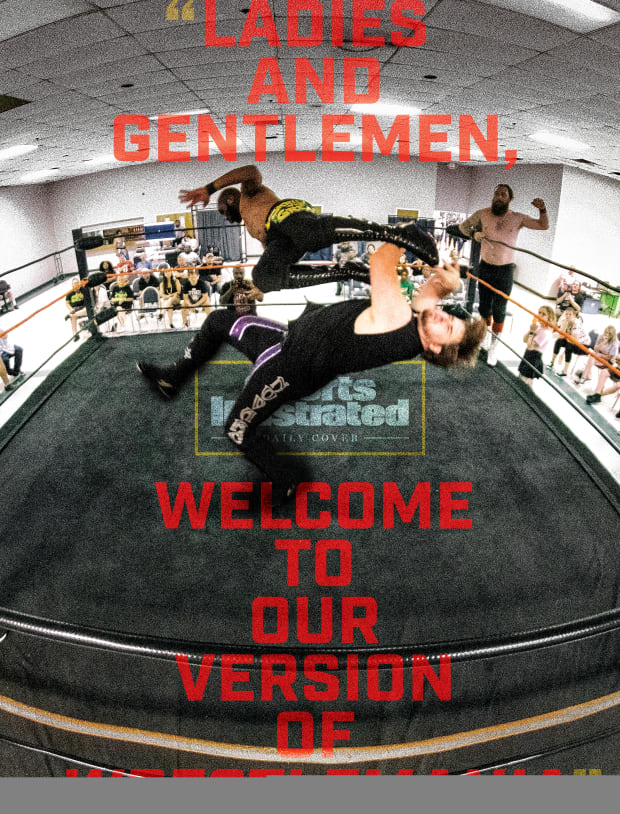
He pauses to take in the faces surrounding him, under a Budweiser-branded chandelier—some white, but almost as many Black and brown, too; more diverse than you’d see in any mainstream wrestling production. “You have the chance to show what you can do. You have the chance to show you belong.”
Black didn’t always lead the locker room speech. Six months ago, after GIPW’s general manager, who was white, unexpectedly died, Black asked the company’s white owners for the opportunity, reasoning that he could connect better with the wrestlers than they could. He’s taken the punches of an indie wrestler trying to make it in the South. He’s hounded bookers to get on a match card and driven hundreds of miles to shows every weekend; he feels the pain of being “stuck on read,” of feeling invisible. And as a Black man, these punches came harder and more frequently.
GIPW’s owners passed the mike. And in Georgia, the second-Blackest of the 50 states, but where
only one Black-owned wrestling promotion exists, this small exchange rings loud, an invitation to say grace at the big, white table of professional wrestling.Out of the 25 athletes on tonight’s card, 11 are Black. An effervescent Black commentator, Tyreke Robinson, will shout into a microphone from a table near the ring. The woman who’ll strike the bell after every three-count pin, Shaloncé Royal, is Black. All five referees, too.
How did a wrestling show on the outskirts of a Georgia city that twice voted for Donald Trump come to be a model of inclusivity? Its bookers set their state’s legacy of segregation aside and hired the best talent.
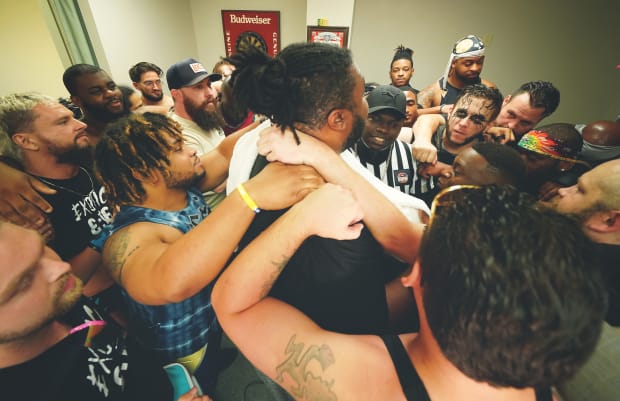
Early in the 20th century, amateur wrestling promoters gazed out at rows of yawning spectators and decided they’d better find a way to amp it up. So they played God. They fixed the matches and directed opponents on duration, instructing them to exaggerate blows and follow the audience’s cues. Like a comedian bailing on a bad joke, a barrel-chested brawler could suddenly change course if the audience lost interest. Bookers then became writer-directors who weighed stage presence alongside athleticism in the hiring equation. Crucially, they could bring in the talent they wanted, cast wrestlers in roles they created and script how far anyone went.
This remains the rubric for America’s most curious almost-sport. Bookers—from teeny promotions like GIPW to the international juggernaut WWE—pit heels (bad guys) against faces (good guys) in a volley of assault and vengeance so rudimentary that a small child can follow along. Eye rake for an eye rake. Backbreaker for a backbreaker. A match unfolds like a soap opera, the plot thickening with every allegorical strike. It’s a fantastical place where wrestler and spectator enter the fray together and walk away unscathed, invigorated.
“Sports entertainment,” pro wrestling tycoon Vince McMahon calls it, partly as a means of avoiding fees imposed by state sports commissions. And it’s genius, this hyperbolic marriage of storytelling and athletics, where the good guy always comes out on top and the everyman often wears the crown.
Except, not every man has gotten a shot at that crown. Historically, the script, like most in American popular culture, has been written by white people, working off a familiar theme of white supremacy and nationalism. In the early days, promoters cast clean-cut white men, often former college football players or amateur wrestling stars, as faces, while those born outside the U.S.—or whose nationality was perhaps less apparent—were written as heels. Later, promoters employed the American fear du jour to bring the heat, wrestlingspeak for vocal fan disapproval, which in this industry is a good thing. No one could rile up a Cold War crowd like Nikolai Volkoff, The Russian Nightmare, singing the Soviet National Anthem ... except maybe the keffiyeh-wearing Iron Sheik, who culminated his catchphrase, “Iran number one, Russia number one,” by spitting on the ring.
This omission of nonwhite players—and the character tropes doled out to those who have been included—reveals the sport’s truest history, one of white gatekeeping, cultural ignorance and the perpetuation of a white-written script that relies on Black performers as supporters rather than stars. Pro wrestling, a century-old industry, is only now seeing noticeable changes at its highest levels.
Those changes, though, started at the bottom, in bars and barns and strip malls. In elementary school gyms and community rec centers. In places like VFW Post 6605.
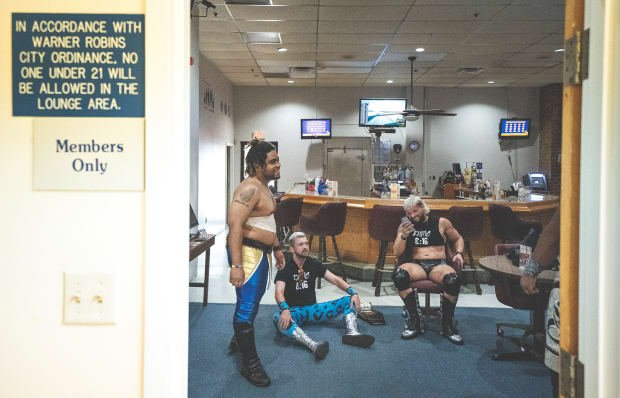
Wrestlers tend to remember the match that hooked them, the one they saw as kids that somehow touched them and kept them coming back for more. Black wrestlers might remember when Ron Simmons defeated Vader to become the first Black champion of a major promotion, WCW, in 1992. Or when Kofi Kingston won the WWE Championship at WrestleMania 35, in 2019, making him just the fourth Black man to take that outfit’s heavyweight title. Or they remember the one that got away.
In 2003, a few weeks before Booker T was to face Triple H for the heavyweight title at WrestleMania 19, the two men met in the ring on Monday Night Raw. With the belt draped over his shoulder, Triple H, who is white, stared down Booker T, who is Black, and stated what might as well have been written in the WWE bylaws: “Somebody like you doesn’t get to be a world champion.”
As boos and chants of “A--hole! A--hole!” rose from the crowd, the reigning champ went on. “People like you don’t deserve it,” he thundered while Booker T’s muscled shoulders rose and fell with quick breath. “You’re not here to be a competitor, you’re here to be an entertainer.” Triple H sneered, poked at his opponent’s “nappy” hair and begged, “Go ahead, do a little dance for me, Book. Give me one of those Spinaroonies,” mocking T’s signature breakdance move. “Entertain me. That’s your job.”
When three weeks later a Black wrestler in his athletic prime, beloved by legions of fans of all backgrounds, brought everything he had to the ring and lost, as scripted, to the white heel (who outside of the ring was engaged to McMahon’s daughter), it felt like an awful joke, and it cast an uneasy silence. To the tens of thousands of fans at Safeco Field, and the hundreds of thousands more watching at home—to anyone who understood the arrangement of it all—it shattered an unspoken truth in wrestling: The bad guy can demean, rattle and knock out the good guy, but the good guy always gets his revenge. To another set, though, it was real.
Brandon Whatley was 10 at the time, and he idolized Booker T. “His size, his athleticism, his swagger, his move set. That’s what got me into him,” Whatley says today. “Seeing another Black male on TV, I thought, Hey, that’s kind of cool he can do that stuff.”
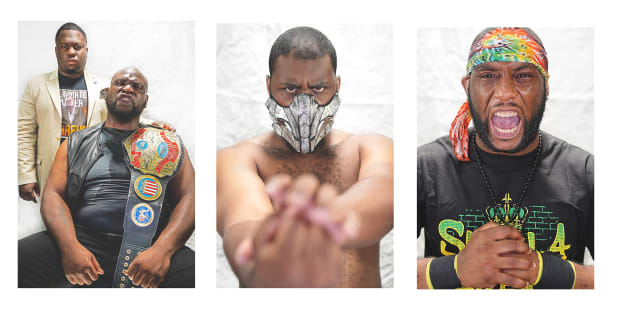
In the days leading up to the big event, young Brandon watched a segment about the real-life wrestler, Robert Booker Tio Huffman Jr.—how he’d grown up the youngest of eight kids; how he was parentless at 13; how at 22 he’d robbed a string of Wendy’s and spent almost two years in prison.
“Being Black and growing up in a bad neighborhood, I could relate to that,” says Whatley, who at the time lived in public housing in Anniston, Ala., where his mother used to rush him back to her room, away from the front of their home, whenever gunshots rang outside. “I thought, If he can make it out of that, I can make it out of this.”
Unable to afford the Wrestlemania 19 pay-per-view, young Brandon instead watched clips on recap shows. And the result crushed him. He couldn’t understand how or why someone as undefeatable as Booker T would lose that fight. It was another punch he didn’t deserve.
Fast forward almost two decades—past Whatley’s one year at a for-profit university, then dropping out and waiting tables at a Waffle House, delivering pizzas, transporting car parts; past five years spent wrestling in small-town rings across Georgia and Alabama, training at the Nightmare Factory, a wrestling school owned by AEW’s Cody Rhodes. Now, by day, Whatley works in a warehouse, moving coat hangers; by night, when he’s not training, he earns extra cash making deliveries for DoorDash. But Friday, Saturday and Sunday—those are the days that count, as he clocks hundreds of miles traveling between small-time shows, with one goal. To somehow, someday make a living in wrestling.
“What if [Booker T] had never gotten into wrestling?” asks Whatley, who logged his first match for GIPW last fall. “I don’t know if I’d be a wrestler right now.”
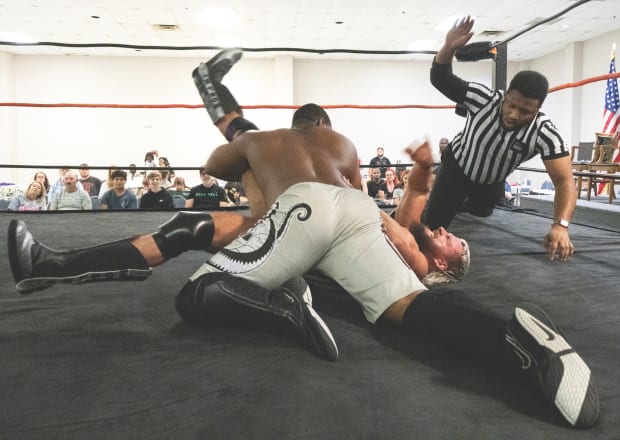
Booker T eventually came out on top three years later, winning the WWE world heavyweight championship—the organization’s highest honor—at The Great American Bash. When it comes to that loss to Triple H, though, he moves past the slight and focuses on the paycheck. “I’ve never … framed my career around any one match,” he said on his podcast in May. “Let alone ... the match where I got paid more money than I got paid for any other match in my life.”
Today WWE has more athletes of color on its roster than ever before, but just being there is not enough. Historically, WWE pushes white wrestlers to the top faster and with more frequency than Black wrestlers. In February, Bobby Lashley, at age 44, became the fifth Black man to hold the company’s highest title, and it came 16 years after he signed his contract. Part of that delay can be attributed to the fact that Lashley left WWE for a decade, starting in 2008, to compete in MMA and wrestle in other promotions—but many people inside the industry link that departure to his butting up against racist forces at the company’s highest rungs. Lashley returned in ’18 and started on a long-coming path upward. (WWE did not offer a comment for this story.)
His, though, is a rare tale. With Black wrestlers in WWE, trajectories have historically been aimed low. And creativity has been curbed. “Their gimmick is typically ‘I’m Black,’ ” says GIPW’s Eric Silva. “That is maybe three things: Either they’re a rapper, a dancer or a criminal.”
History backs up his point. Junkyard Dog wore a collar and chain around his neck. Kamala—actually Mississippi-born James Arthur Harris—wrestled as The Ugandan Giant, who spoke in grunts, wore a loincloth and was escorted to the ring by a white handler wielding a riding crop. In 2007, WWE writers asked Mark Henry to adopt the moniker Silverback, a proposition he publicly and adamantly opposed. A year later, WWE signed Shad Gaspard and Jayson “JTG” Paul, booking them as Cryme Tyme, a duo of fast-talking thugs who greeted the camera with a synchronous “Yo, yo, yo, yo, yo!” Fans got to know them for their pre-show antics: scalping fake tickets, stealing wallets, getting handsy with women and beating people with bats. They spat slang at auctioneer speed, making their words unintelligible to their white opponents, who would say as much before dismissing them.
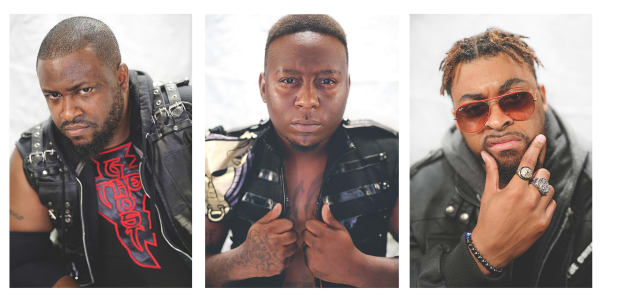
JTG and Gaspard baked up the characters themselves, as a way in. They knew McMahon would bite, and he did. Asked now if Vince would have cast them as two smart, well-dressed Black men, JTG’s answer is resolute: “No.”
Rather than scripting Black wrestlers as standout stars in singles matches, white writers have typically corralled them into heel stables like the Black Panthers–inspired Nation of Domination, whose militant, anti-white dialogue was written to stoke fear. Recently, a collective branded The New Day—Kingston, Big E and Xavier Woods—has evolved into something promising, but it’s taken a bit of work. In 2014, WWE first introduced the group as choir-backed, dancing preachers.
Increased media coverage of racial inequality has compelled fans of all walks to speak out against WWE’s nasty habits of reserving its most prized belts, largely, for white wrestlers—and of perpetuating offensive stereotypes, like in 2019, when the company sold T-shirts promoting Black wrestler Jordan Myles that evoked racist “Sambo” imagery. Black Writers such as Forbes’s Alfred Konuwa, and The Undefeated’s Martenzie Johnson and David Dennis Jr., are de facto ombudsmen, keeping tabs on the evolving WWE and its sordid moments, including Kingston’s one-sided match against Brock Lesnar in 2019, in which Kingston lost the championship belt in just nine seconds. And WWE’s recent breaking up of The Hurt Business, a crowd-favored stable of wrestlers whose gimmick revolved around them being successful, driven Black men.
Movements like Black Lives Matter and #OscarsSoWhite have inspired structural change, too, if only at the lower levels. In the past two years alone, wrestlers, promoters and fans have banded together to produce all-Black shows, including Black Wrestlers Matter, For the Culture, Good Trouble and the Pan Afrikan World Diaspora Championship. These events have been as much a way for a group of marginalized participants to tell their own stories as they are a response to WWE’s most offensive crime: omission.
But for some small promotions, elevating Black wrestlers has been de rigueur for a while. “Even before me, most of the roster was Black,” says Matt Hankins, proprietor of Georgia's sole Black-owned promotion, Platinum Championship Wrestling (PCW). “When those guys would come down here to PCW,” he says of Black wrestlers who traveled in from other Southern states, “they felt like they’d gone to Wakanda.”
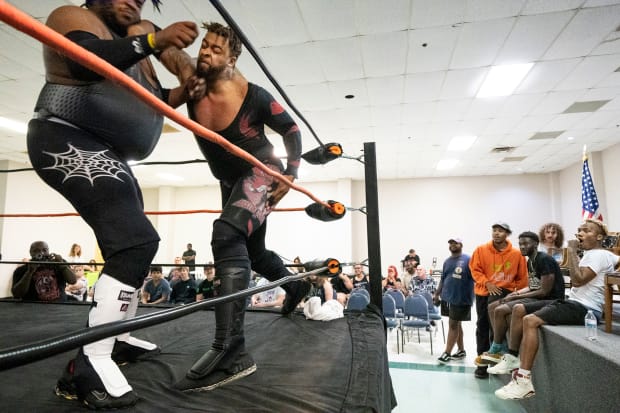
In the indies, wrestlers of all backgrounds create their own characters, bringing amplified or dream versions of themselves to the ring. Unquestionably, there are more Black wrestlers and more Black champions on these lower tiers, because, says Ehren Black, “the big leagues just don’t think we can do it.” And that doubt can trickle down. He remembers sitting on a couch with a friend two years ago, watching WrestleMania 35, when Kingston challenged Daniel Bryan, who is white, for the WWE championship. As Black watched, the apprehension fostered by two decades of fandom crept in. “I thought it was going to be another Booker T situation,” he says. Instead, Kingston pinned Bryan for the win and tears welled up in Black’s eyes. “It was like, Wow, one of us finally made it to the top. I felt like it was a win for all of us.”
Popular culture informs society’s perceptions of people and places. All too often, on-screen messages are color-coded, and in professional wrestling Black has often translated as bad or goofy or unworthy. In a form of entertainment that appeals to kids who often cannot discern fact from fiction, it’s crucial that those wielding power—those who write the stories that shift how people view themselves and others—combat systemic racism by destroying and not perpetuating such stereotypes.
“One of the main reasons we wrestle is because we want people who are younger than us to see somebody who looks like them doing extraordinary things,” says AC Mack, a Black and gay independent wrestler based in Atlanta. “We want them to see people breaking down barriers—hearing no, going around that, and creating their own yes.”
Mack did his part in April, traveling to Tampa to wrestle in two inclusion-themed indie shows—For the Culture and Effy’s Big Gay Brunch—in the days leading up to Wrestlemania 37. But he also saw the long-term rewards of such efforts play out on a larger stage as he attended both nights of WWE’s tentpole event. Watching from 30 rows back, he witnessed nine Black wrestlers compete in singles or tag-team matches (more than at any WrestleMania in history) and four Black wrestlers earn or retain belts (also a record), including the intercontinental championship, which Apollo Crews won over Big E, the first time that two Black men vied for the title at WrestleMania. Throughout, overjoyed fans affixed their tweets with tags like #WrestleMelanin and #BlackestManiaEver.
It’s a start, though, not an end, says Forbes’s Konuwa. “I will be satisfied when it’s like, Of course Bianca Belair is headlining WrestleMania. Of course this Black person won the WWE title. When it’s the rule, as opposed to the exception. You don’t celebrate the country club that finally lets Black people play on the golf course in 2021. It’s embarrassing that the WWE has taken this long.”
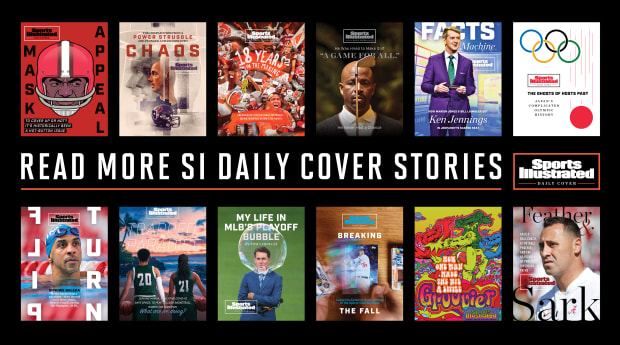
Coming from the northeast, the country-road drive toward the military town of Warner Robins crosses through Eatonton, birthplace of two well-known, if disparate, Georgians: The Color Purple author Alice Walker, and Joel Chandler Harris, writer of the Uncle Remus tales. At one point, square in the middle of the state, the path joins with the Antebellum Trail, a 100-mile roadway connecting seven cities that Union general William Tecumseh Sherman deemed too beautiful to burn on his way south in 1864.
In Georgia, this is flyover country. I-75, which connects Michigan’s Upper Peninsula almost to the tip of Florida and slices through the western edge of Warner Robins, is so trafficked by passersby that the Texas-based convenience megastore chain Buc-ee’s built a 53,000-square-foot compound around these parts, with 116 gas pumps that invite travelers to refuel quickly and move on. If you do stop in Warner Robins, it’s likely with aims toward Robins Air Force Base, which is three-quarters the size of Manhattan and employs 23,000 people.
But stick around on a Sunday afternoon and you might discover something else. A few years ago, the directors of the Shia LeBeouf movie The Peanut Butter Falcon, about an aspiring grappler with Down Syndrome, were scouring YouTube for extras working around Savannah, where they were filming. And in their e-combing they found footage of Warner Robins wrestlers pounding it out in GIPW owner Eric Dees’s own backyard. Producers hired the locals, and around the movie’s 1:20 mark Skrilla the Great, who is Black, and Tony James, who is white, bloody each other with fist and chair to tee up the climactic scene.
Dees created GIPW in 2019, starting with that very backyard ring, which he purchased with his National Guard retirement check; it was his way of feeding what he sees as an unsatiated hunger for wrestling in the area. “When WWE comes, the [Macon] Centerplex sells out pretty much every time,” says Dees, who a decade ago was chasing a rap career alongside Skrilla. Now he wrestles as Dee Money and manages the business side of GIPW while Donn Kester, another vet, whose grandfather once ran a wrestling promotion in Kinston, N.C., writes the shows and books the talent.
If WWE is the equivalent of Major League Baseball, and promotions like Ring of Honor, Impact and the newly reborn NWA are the minor leagues, then a hometown show like GIPW amounts to a Saturday afternoon softball league. Which doesn’t make it any less thrilling. Or satisfying. There’s a sense among fans that the creativity in characters and storytelling seen at this level is absent at the higher rungs. “It’s freedom,” says JTG, who after his stint with Cryme Tyme in WWE now wrestles in the indies as Jay tha Gawd. “That’s why I love the independent scene. You’re free to do whatever you want.”
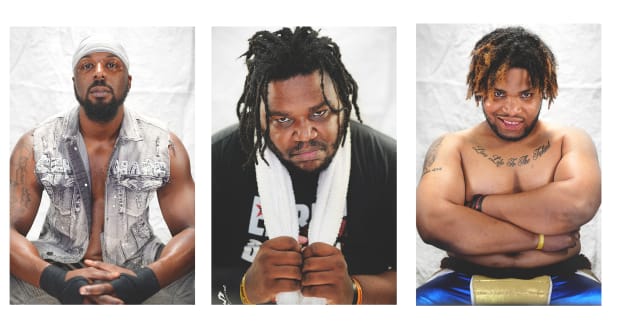
Which is why on a February Sunday night in Warner Robins you’ll see Eric Silva in a grommeted leather getup; and Bryce “Frat Daddy” Cannon in bedazzled blue-velvet hot pants; and Pastor Troy in his clerical collar, escorting Wild Thing to the ring; and Jack Kujo, hanging on the top rope in a jean jacket, pounding his fist to Bon Jovi’s “Livin’ on a Prayer.”
The most effective personas echo their creator’s true self. It’s me, turned up, is a popular line. And so Whatley’s Serpent Assassin is a mashup of his favorite screen heroes: Reptile, from Mortal Kombat; Darth Maul, from Star Wars; Tommy, the green Power Ranger; and Bruce Lee. Silva models his persona after Blade, and the main character on Dexter—“an intellectual bully.” And Austin Towers, The Chief, enters the ring to a song that inspires him, Jidenna’s “Long Live the Chief,” which includes the lyric “You can either sink, swim or be the captain.” (The name, he says, is not meant to evoke any Native American heritage, as was the case with the ’80s-era WWF wrestler Chief Strongbow, who was played by an Italian American.)
A diverse roster brings diverse fans. Tonight, in a community center usually reserved for craft shows and ribeye fundraiser dinners, attendees include a bearded white man wearing a leather vest that announces, beneath an American flag, THESE COLORS DON’T RUN; and a Black father of four, Deundre White, who grew up watching the sport. White points to a kid playing on the floor with a wrestling action figure and reminisces, “I had toys like him. Rings, cages, everything. I was a fanatic, and I am still.”
Between matches, along one wall of the room, wrestlers meet and greet and hold down merch tables. At Whatley’s booth he’s selling a shirt on which his illustrated likeness wields a pair of nunchuks; on another he springs forth wielding a sword. “That’s the ProSouth All-Out Championship,” he says, pointing to a belt displayed next to a grid of 5-by-7 portraits tagged $3 apiece. He earned the belt in December, at an event in Piedmont, Ala. Two weeks before that, he took home the tag-team belt at a Southern Violence and Wrestling show, in Athens, Ga.
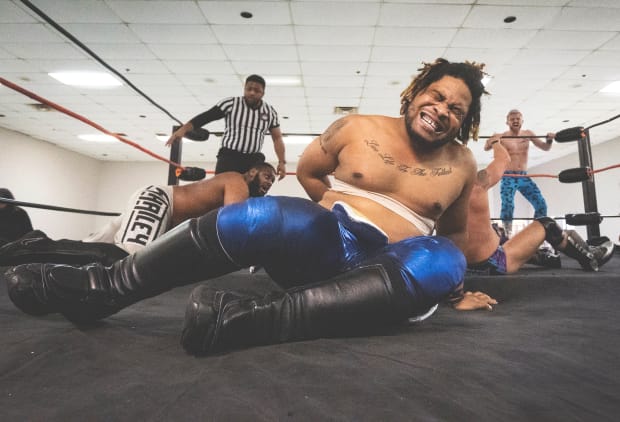
At the adjoining booth, Ehren Black hawks short-sleeved EHREN’S GONNA KILL YOU T-shirts and lords over the GIPW tag-team belt that he will defend tonight alongside Towers, his partner in the West Coast Kings. A white kid in neon-green basketball shorts and a fresh haircut walks up to the table. “Ehren?” he asks, as if his hero couldn’t possibly be standing right in front of him.
“What’s up, brother?” Black smiles.
The kid pauses, starstruck. “I’m glad you’re back.”
“Glad to be back.”
The boy looks down, considers his words. “I like when you came back and beat the crap out of Bryce Cannon,” he finally says, recalling GIPW’s December show.
“That was my favorite moment too,” says Black, grinning and laughing.
“He sent you to the hospital. You should’ve sent him to the hospital!” the boy continues, his confidence buoyed by the easy back and forth.
“You know what? That might be the plan tonight,” Black says, beaming a knowing smile. “That might be a good idea.”
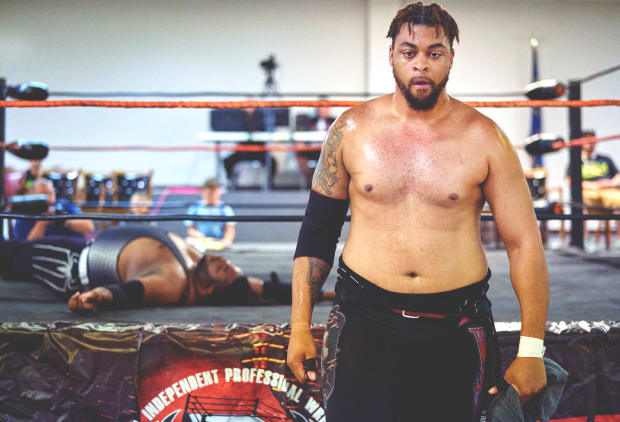
An hour later, ring announcer Cliff McDonald booms into his microphone: “The following match is sponsored by the Pat Pawlor, located at 2318 Moody Road, Warner Robins, Ga., for all your pet-grooming needs.” The ensuing match, a tag-team affair between Money, Power, Respect (an all-Black group named after a 1998 hip-hop song that has evolved into a cultural touchstone for Black Gen Y’ers) and a trio called V6 (made up of Latino, Black and white wrestlers), comes to a conclusion when MPR’s Renegade Enforcer, a security guard by day, hits Jack Kujo with a martial-law suplex. Over the course of the next two hours, two in-on-the-act fans will pin Silva to a chair, shouting “One more time!” as Shawn Angelo Montana dispenses kicks to the chin. And in another match, 6' 8" Madman Fulton will put his boot through a drop-ceiling panel when he goes bottom-up in a suplex. (He’ll later apologize to VFW staff and replace the panel.)
The loudest cheers and most guttural boos, though, are reserved for the triple-tag-team championship match between Black’s West Coast Kings, The Menagerie and Exotic Youth, which is governed by GIPW-patented “Unchained” rules: Two men start in the ring, the remaining four are each bound to a post, and the ref frees someone every two minutes. Deep into the contest, with both members of The Menagerie eliminated, Black stands alone in the ring with Cannon, his White Claw-swilling, frat boy nemesis; and Cannon’s tiedye-wearing sidepiece, Cornelious Pepperbottom, both men white and undersized. Pepperbottom hulks a banquet table into the ring, and he and Cannon hoist the wobbling Black toward it. But Black rebounds. He choke-slams Pepperbottom and eyes Cannon. The crowd starts chanting—“Eh-ren’s gon-na kill you! Eh-ren’s gon-na kill you!”—and as Cannon comes at him with a disaster kick Black grabs the incoming leg, thunderbombs Cannon into the table and lands on top of him for the pin.
There’s a pop, ring-speak for an exceptionally loud cheer from the crowd, and Towers leaps in under the bottom rope to join his partner in victory. But while wrestlers and fans alike live for that pop, the most resonant moments can sometimes be much more quiet.
At the start of the third match, a six-year-old boy leapt from his seat and bounced on his haunches as Whatley hopped onto the apron and forward-rolled into the ring, landing in a ninja stance. The child, Deundre White’s son Justin, threw his fists in the air and shrieked as The Serpent Assassin sunk down, burst into a jumping spin-kick and landed in a pounce position. The wrestler jutted his arms out in front of him, one hand closed, one open, forming into the green Power Ranger’s trademark dragon fist, and hissed at the crowd.
To a six-year-old boy, the world shrank down to the size of a 16-by-16 foot ring, and he fixed his gaze upon the man commanding it. Justin jutted his arms out in front of him, one hand closed, one open, forming into a dragon fist. Just like Brandon Whatley.
Alison Miller is a freelance writer and editor based in Athens, Ga.
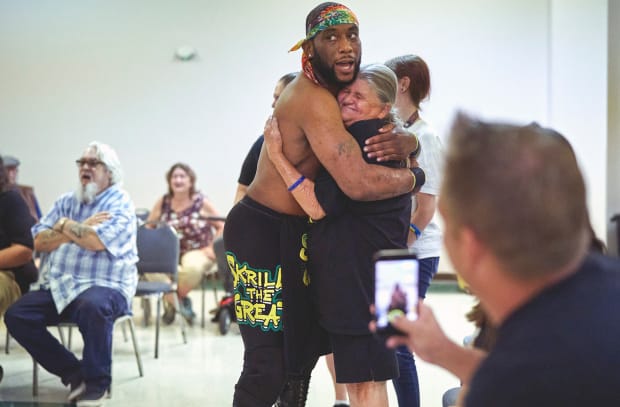
• NFL Cheerleaders' Fight To Be Heard
• How Michigan Football Failed to Protect One of Its Own From Sexual Assault
• Phillip Adams Took Six Lives, and Then His Own. How Many More Were Ruined?
Paul George silenced his doubters with a dynamic second half as the Clippers extended their season.
Welcome to the Morning Shootaround, where every weekday you’ll get a fresh, topical column from one of SI.com’s NBA writers: Howard Beck on Mondays, Chris Mannix on Tuesdays, Michael Pina on Wednesdays, Chris Herring on Thursdays and Rohan Nadkarni on Fridays.
PHOENIX – The ball squirted loose, Cam Johnson picked it up and in that moment, every critic of Paul George began warming up sizzling social media takes. A pair of turnovers and a sloppy foul from George had freed the Suns to whittle what was a 13-point fourth quarter lead down to four. A Finals-starved crowd of more than 16,000 roared inside Talking Stick Resort Arena. Legions of George doubters prepared to do the same.
This was where George and the Clippers would crumble, where “Playoff P” would become a punchline, where L.A.’s constant flirting with disaster would finally lead to one. Only it didn’t. Reggie Jackson punched back first, drilling a three-pointer to grow the lead to seven, part of an eight-point outburst in two minutes. Then, George. A short jumper pushed the lead to nine. A pair of free throws and a 20-footer swelled it to 16. George’s final two points—a pair from the line that accounted for points 40 and 41 in a career-best playoff scoring night, icing an eventual 116–102 win—came as thousands of stunned fans began streaming towards the exits.
“PG,” said Tyronn Lue. “It’s been PG all playoffs.”
Marveled Clippers teammate DeMarcus Cousins, “That's one of the most special players to ever lace his shoes up.”
This has been a postseason filled with remarkable accomplishments for the Clippers, but Monday’s may have been its best: Down 3–1, facing elimination and with Ivica Zubac joining Kawhi Leonard and Serge Ibaka on the shelf, L.A. is still alive and headed home. A 20–5 run to start the game set the tone, a seven-point halftime lead preserved it and an 18–8 run to finish the game propelled the Clippers to arguably the biggest win in franchise history.
“They played with determination,” said Suns coach Monty Williams.
Jackson did. He signed a one-year, $2.3 million deal to return to the Clippers last December and honestly, has any role player in these playoffs been more valuable? It was Jackson who served as the Clippers’ spirit on Monday morning, cracking jokes, bringing energy to a team that woke to discover its most reliable big man, Zubac, would be out with a knee injury. “He was talking trash all day,” said Lue. In the game, Jackson was everywhere, slashing to the lane for layups over DeAndre Ayton, pulling up from three for four of the Clippers ten three-pointers.
Marcus Morris did. Morris has battled a knee injury of his own in recent weeks, one that has required regular treatment. An hour before the game, the pain lifted. “I felt better than I had in previous games,” Morris said. The result: a 41-minute tour de force, from sturdy defense on the 6’11”, 250-pound Ayton (10 points) to a 22-point effort on the offensive end. “Just [putting] my body on the line,” Morris said. “The main thing is just get back to L.A. We'll figure it out once we get back home, and that's what we did.”
Lue did. Lue’s stock has soared in these playoffs. His decision to go small saved the Clippers from a first-round disaster against Dallas, and a similar move against Utah helped engineer a six-game win in the second round. With Zubac out, Lue started small, only to dip into his bench for Cousins, the break-glass-in-case-of-emergency big man who had played sparingly this postseason. Cousins responded with 15 points in 11 minutes.
This series, this season would be over without George. Inside the Clippers’ locker room, the criticism that hounds George is mystifying. “I don't know where this trolling bull---- has come from where the internet controls the narratives about these players,” Cousins said. “It's becoming foolish, man.” But it’s there. George played poorly in Game 4, missing 15 of his 20 shots, eight of his nine threes and six of his 18 free throws. Memories of back-to-back playoff failures in Oklahoma City remain fresh. Last season’s blown 3–1 lead to Denver is fresher. George isn’t singularly responsible for any of those defeats, but he has become a magnet for criticism for all of them.
“I do,” George said, when asked if he felt overly critiqued. “And it’s the honest truth. It’s a fact. But I can’t worry about that. It comes with the job, I guess. But it is what it is. I still try to go and dominate, whether I’m shooting the ball well or not shooting the ball well. I still try to dominate, just the whole game in general.”
Early on, George didn’t look like a player coming to dominate. His first half was largely listless, highlighted by turnovers (six overall) and passive play. In the third quarter, George broke out, scoring 20 points, beating back a Suns team that briefly squeezed out a one-point lead by scoring five quick points to put the Clippers back on top. With Jae Crowder, Mikal Bridges and a parade of sturdy Suns defenders draped over him, George powered into the paint, getting to the free throw line eight times—and making all eight of them.
“I just don't understand why it's magnified so much when he doesn’t play well, when he has a bad game,” Lue said. “A lot of people play bad. I'm just happy he came back and played a great game. We needed every bit of it.”
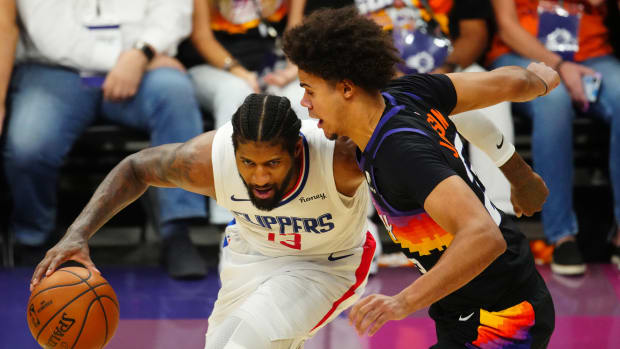
It was just after 9 p.m. when George made his way to a makeshift press conference, a dozen reporters in the room around him, dozens more connected via the Zoom camera in front of him. A sweat soaked tee shirt clung to George’s 6’8” frame, evidence of the effort he has put in. His 735 minutes through 18 games are an NBA high, 130 more than Devin Booker, his closest competition. George acknowledged the stress of the day (“Losing another starter … was tough,” George said), praised Lue for his level headedness (“He's just great at just staying calm and collected.”) and declared that this Clippers team was not going to roll over.
“If they were going to finish this series off, they were going to have to work for it,” George said. “We weren’t going to just throw in the towel. The fact of the matter is, they got to beat us.”
Indeed. The Clippers didn’t regain control of this series on Monday. Far from it. They still trail 3–2, and will need to win in L.A. and Phoenix to advance. But there is a noticeable confidence. George and Morris reminded reporters just how close these games have been. That if not for the Valley-Oop in Game 2 and an anemic offensive performance in Game 4, this matchup could look decidedly different. “This series easily could have been 3–1 our way,” said Morris. And with Leonard, Ibaka and Zubac on the sidelines, the pressure is on Phoenix now. The Clippers are suddenly the team playing with house money.
George, though, believes the Clippers can win. And his team believes in him. “We don’t have to pump him up,” Cousins said. “He’s going to make the right play, and he’s unguardable.” As George exited the game, Lue pulled him close. Neither would reveal specifics of the conversation (“A lot of MFs and bleep-this and bleep-that in there,” George said) but the message was simple: Way to play. Two more. L.A. has already been left for dead twice now. The Clippers, yet again, are not dead yet.
More NBA Playoffs Coverage:
• Beck: The Irony of the Mavericks' Hires
• Pina: The NBA Playoffs All-Money Team
• How It Feels to Watch the Team You Built Thrive Without You
• The NBA Is Enjoying the Chaos
This two-round mock draft gives the Steelers a new starting quarterback.
Rodney Hudson, J.C. Tretter and Corey Lindsey top Touchdown Wire's list of the best in the middle.
Former Oklahoma Sooners quarterback Baker Mayfield ranked as a top 10 quarterback.
Quarterback Ryan Fitzpatrick hasn’t had too much time on the field with his new teammates in Washington, but he’s apparently made the most of the time that they have had together. Washington linebacker Jon Bostic said on SiriusXM NFL Radio that it only took a few snaps for him to see the high level of [more]
The new owner in Utah wanted to get his coach and front office on the same page.
The Clippers' Reggie Jackson uses cool, calm demeanor before and during Game 5 and scores eight of his 23 points in the fourth quarter in win over Suns.
It's rare for sports cases to reach the highest court in the land, but a unanimous decision is a harbinger of much larger industry changes to come.
We are clearly at an inflection point in college athletics. Last week a seminal case on rights of college athletes produced a beatdown of the NCAA from the highest court in the land. And as of this Thursday, name, image and likeness (NIL) rights for college athletes are upon us, whether the NCAA likes it or not. Let’s examine.
One can count on two hands how often a case involving sports has reached the U. S. Supreme Court, so sports business and law nerds like myself were giddy last week when it happened in a case regarding limitations on benefits for college athletes.
In a 9–0 unanimous decision, the Supreme Court upheld the lower court’s decision that NCAA restrictions on “education-related benefits” for college athletes violated antitrust law. Justice Neil Gorsuch authored the majority opinion in favor of the plaintiffs, albeit a narrow decision dealing only with education-related benefits and not the larger issue of pay-for-play or other big-picture issues with college athletes. And there was language the NCAA has since claimed as a “win” for itself: It was still free to create limits on benefits unrelated to education.
While there was a narrow focus to the overall ruling, the case, as noted below, appears to be a harbinger for the NCAA of things to come.
Trying to read the tea leaves from oral arguments with a Supreme Court case is a dangerous exercise, but in this case the questioning held true to form. Justice Brett Kavanaugh was clearly the most strident justice in his questioning of the NCAA lawyer during the presentation of the case, and his written concurring opinion took a sledgehammer to the organization.
Kavanaugh attacked the circular nature of the NCAA’s argument that athletes’ not being paid is a defining feature of college sports and drew stark analogies to how preposterous the NCAA’s business model would look in other industries: highly violative of antitrust law. Here is one of his many savaging remarks: “Nowhere else in America can businesses get away with agreeing not to pay their workers a fair market rate on the theory that their product is defined by not paying their workers a fair market rate. … The NCAA is not above the law.”
Justice Kavanaugh seemed to be inviting the next plaintiff—and there are already many circling—to “bring it on” to the Supreme Court, where he will be waiting to rule on a much bigger and broader issue than education-related benefits. Brett Kavanaugh, enemy of the NCAA. Who knew?

As noted above, this case did not take up the issue of pay-for-play that many have advocated for and that typically brings the headlines. Why, then, did the plaintiffs and superlawyer Jeffrey Kessler not argue for broader change in this case, which we now know would have been well-received by at least Justice Kavanaugh? Well, that decision appeared to be strategic; the plaintiffs wanted a “win,” which they got, rather than risking a loss on broader issues.
Even with the narrow decision, there will be reverberations from this decision immediately. We are not naive to what happens in the uber competitive world of college athletics, especially without a clear definition of what “education-related benefits” are. With ambiguity, as there is now, the definition of these benefits will expand. Who is to say whether an athlete should have a $2,000 computer or a $10,000 computer? A $1,000 video monitor or a $20,000 video system that has high-quality streaming of lectures, which can also serve as a gaming device and home entertainment system? A $5,000 internship or a $50,000 internship? The NCAA may still enforce any “no Lamborghini” rule, as the court put it, but there are a lot steps between spartan education-related benefits and a Lamborghini.
As for broader issues, their time is coming. A couple of days after the decision, there was a hearing on the case of House v. NCAA, a case where the plaintiffs are requesting that the NCAA not be allowed to have NIL restrictions on the athletes. The NCAA’s motion to dismiss that case was denied. And speaking of NIL …
A new age of marketing and branding opportunities for college athletes is dawning on Thursday, with the NCAA’s plodding acceptance. As we continue to note, the NCAA’s change in treatment of athletes seems only motivated by the two “L” words: litigation and legislation. And both have initiated change regarding name, image and likeness.
There were already six states—including Florida and Texas—with NIL legislation set to go into effect on July 1. Schools in those states have been able to tell their athletes with confidence about NIL opportunities, creating an immediate imbalance that was already being exploited in recruiting. The NCAA, hounded by legislators as it has been hounded by judges, had to act. And in many ways, the NCAA is ceding its authority in this area to the individual schools and conferences themselves, especially in states without NIL laws, as if to say, “We wanted to slow play this, but I guess it’s too late. You guys handle it!”
This is stunning to me. As someone who had been part of planning meetings around NIL—within my purview at Villanova and the Big East Conference—I am keenly aware that the NCAA has had working groups on this issue for more than two years. Thousands of hours have been devoted to the erecting of “guardrails”—their phrase, not mine—to ensure that NIL rights are not to be confused with “pay-for-play” and that schools’ logos and marks won’t be used. Now, although states and schools will incorporate some of those similar guardrails, more than two years of work by many good and talented people across hundreds of universities is being pushed aside for a more decentralized process. The NCAA seems to be throwing up its hands, perhaps too rattled from the Alston decision to enact any policy restricting college athletes at this time.
One important change that has to happen immediately is this: The NCAA and its member schools need to take a different attitude toward agents. Schools and coaches need to now understand that agents—NIL agents—will be around their players in a way that has faced so much resistance before. The presence of agents is not only now allowed but even encouraged.
Who qualifies as an NIL agent and how are they regulated? Well, that is a good question, with the only NCAA guideline so far being that these agents are not allowed to be agents seeking representation of the athletes for their pro careers, only for NIL opportunities. Good luck enforcing that.
As I hear from them every day, I know that there are so many young people trying to enter into the agent business, and there are many barriers to representing athletes in their professional careers. Here, however, is an opening that many are trying to use to wedge their way into that world. I have made videos for our Villanova athletes as to what to look for and not look for in NIL agents. It could be the wild, wild West out there, but at the end of the day, the NCAA brought this upon itself, dawdling while legislation and litigation pecked away.
Speaking of my role at Villanova and my involvement with the athletics department there, I admit to conflicted thoughts here. We have 650 athletes in 24 sports, only one of which—the one that has won two of the last six NCAA men’s basketball championships—makes money. I know how fragile the ecosystem of college athletics is beyond the outliers of top college football and basketball programs. And I know that, despite the perception of unlimited funds from boosters and donors, most sports struggle to stay afloat. However, as a scholar in sports law, I also know that fairness and “justice” require more compensation for these athletes, no matter the veil of amateurism. We have seen the model change in Olympic sports, and we are seeing it change in college sports as well.
We are clearly at a transitional stage for the NCAA. A broader pay-for-play case may be coming, and the Supreme Court seems to be telegraphing to lawyers and plaintiffs, and there are plenty of them out there circling, to bring them another case. And now NIL rights to monetize student-athlete brands are here.
Change is afoot, and change is usually a good thing. Stay tuned.
More From Andrew Brandt:
• Mailbag: Aaron Rodgers, Julio Jones, Vaccines and More
• Aaron Rodgers Speaks; Adam Vinatieri Was Almost a Packer
• A Three-Pronged Solution to Keep Aaron Rodgers a Packer in 2021
The Eagles went from Super Bowl champs to total dysfunction in a hurry.
Guard Jonah Jackson stepped into the Lions starting lineup after being selected in the third round of last year’s draft and he remained there for all 16 games of his rookie season. Jackson turned 24 in February and his run as the team’s youngest starter on the offensive line ended in April. That’s when the [more]
Ndamukong Suh comes clean on role in dividing Dolphins' locker room
Watch: Jaylen Waddle showcases speed, agility in recent workout
Before this year’s draft, Texas A&M head coach Jimbo Fisher said that quarterback Kellen Mond “does all of the things you need to judge a first-round player” in a push to get the former Aggie starter to go in the first 32 picks. Mond wound up staying on the board into the third round, which is [more]
The left fielder is one of three players in history to hit 15 home runs in a 17-game stretch. He just wants to “keep riding the wave.”
Welcome to The Opener, where every weekday morning you’ll get a fresh, topical column to start your day from one of SI.com’s MLB writers.
According to the Nationals, Kyle Schwarber is one of three players, along with Barry Bonds in 2001 and Sammy Sosa in 1998, to hit 15 home runs in a 17-game stretch. According to MLB, Schwarber is the second player, along with Frank Howard in 1968, to hit 11 home runs in a nine-game span. According to Baseball-Reference, Schwarber’s 1.465 OPS batting first makes him the best leadoff hitter of all time.
According to Kyle Schwarber, hitting home runs is fun. Counting them is boring.
On June 12, Schwarber sat in 56th place in the majors with 10 bombs. The next night, Nationals manager Dave Martinez moved his left fielder to the leadoff spot. Sixteen days later, after Schwarber added another two in Washington’s 8–4 victory over the Mets on Monday, he had climbed to fourth place, with 24 homers.
He smiled politely on Monday when informed of some of the history he is making. “I love when you guys come out with some cool stats,” he said. But he rarely pays attention to the numbers. “I think it's best if I don't, just because, to be honest with you, I want to play stupid,” he said. “That's kind of the best way to describe it—just keep going up there and take your at bat, don't remember the one before, just live in the present. That's kind of the biggest thing. And I think that goes for when everything's going good and also when things aren't working out, just being able to turn the page and focus the at bat that's at hand or the inning that’s at hand or the out on defense, things like that. I think that's the biggest thing, is just go out there and have a short memory.”
His memory does run as far back as this winter, when anyone could have had him. He floundered to a .701 OPS in 2020. MLB Trade Rumors projected he would make between $7 million and $9.3 million in his final year of arbitration. In December, the Cubs declined to tender him a contract, making him a free agent. A month later, the Nationals signed him for one year and $10 million. He promised GM Mike Rizzo that he would give the team everything he had.
“I wouldn't say that I'm going out there and trying to prove the team that I got let go from [wrong],” Schwarber said, noticeably avoiding the word Cubs. “It's more about going out there and doing it for me, knowing that I'm a better baseball player than I was last year.”
He had once been a collegiate catcher whom Cubs president of baseball operations Theo Epstein had compared, in a late-night email, to David Ortiz. “Let’s stick this dude right between Javy [Báez] and [Kris] Bryant and call it a day,” Epstein wrote. Seven months later, Chicago made Schwarber the fourth pick of the 2014 draft. A year after that, he made his major league debut. That October, he clobbered a shot onto the top of the right field video board at Wrigley; the Cubs encased the ball in plexiglas. He was a star on the rise.
Then, in April 2016, he collided with center fielder Dexter Fowler and tore two ligaments in his left knee. Doctors told Schwarber he would be back by spring training. By the NLCS, he was taking secret batting practice in the middle of the night at Dodger Stadium. He played two games in the Arizona Fall League. He started at designated hitter in all four World Series games with the American League rules. He hit .412 as the Cubs grabbed their first title in 108 years.
He was never quite the same afterward. He can be a bumbling fielder, even in left, and he has not hit consistently. He has not reached the All-Star heights to which he once seemed destined. After the disappointment of last year, a Chicago team trying to cut costs decided to cut bait.
He says work with Nationals hitting coach Kevin Long has helped him repeat his swing mechanics. Schwarber says being surrounded by a great lineup has helped him see good pitches. He says he is just trying to “keep riding the wave.”
Meanwhile, his teammates burst out laughing when he sends another ball into outer space. Martinez taps his head and grins when asked if moving Schwarber to leadoff is the best managerial decision of his career. And the Nationals march up the NL East standings, to where they now sit at .500, three games behind New York. Those odds aren’t bad. Just don’t ask Schwarber to calculate them.
More MLB Coverage:
• MLB Announces All-Star Game Finalists, Second Phase of Voting Ends July 1
• Sticky Stuff Enforcement Is Already Making Baseball a Better, Fairer Game
• 'A Game of Speech'—But Also, For Baseball Interpreters, So Much More
• MLB Power Rankings: Padres Surge While Yankees Tumble